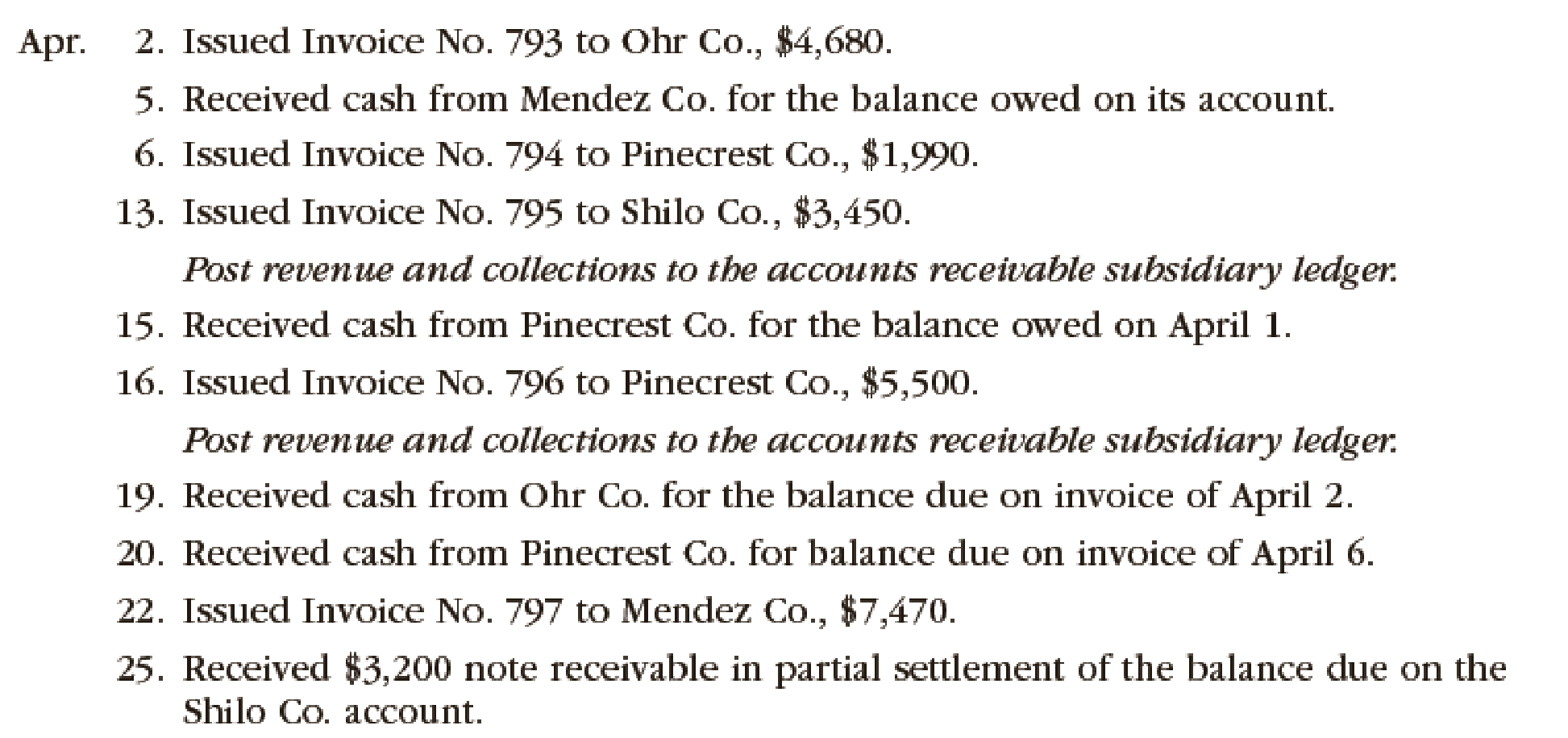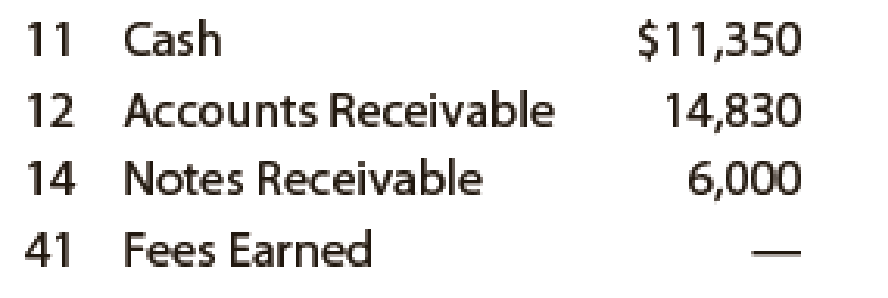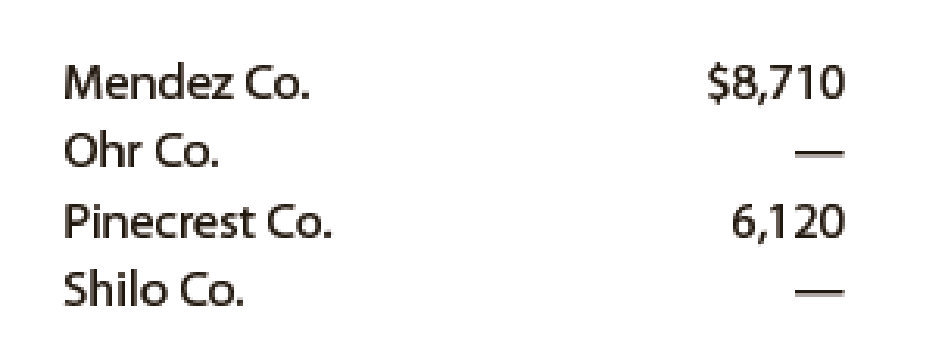
Transactions related to revenue and cash receipts completed by Crowne Business Services Co. during the period April 2–30 are as follows:


Post revenue and collections to the
Instructions
- 1. Insert the following balances in the general ledger as of April 1:

- 2. Insert the following balances in the accounts receivable subsidiary ledger as of April 1:

- 3. Prepare a single-column revenue journal (p. 40) and a cash receipts journal (p. 36). Use the following column headings for the cash receipts journal: Fees Earned Cr., Accounts Receivable Cr., and Cash Dr. The Fees Earned column is used to record cash fees. Insert a check mark (✓) in the Post. Ref. column when recording cash fees.
- 4. Using the two special journals and the two-column general journal (p. 1), journalize the transactions for April. Post to the accounts receivable subsidiary ledger, and insert the balances at the points indicated in the narrative of transactions. Determine the balance in the customer’s account before recording a cash receipt.
- 5. Total each of the columns of the special journals and
post the individual entries and totals to the general ledger. Insert account balances after the last posting. - 6. Determine that the sum of the customer balances agrees with the accounts receivable controlling account in the general ledger.
- 7. Why would an automated system omit postings to a controlling account as performed in step 5 for Accounts Receivable?
1. and 5.
Prepare general ledger for given accounts.
Explanation of Solution
General Ledger: General ledger refers to the ledger that records all the transactions of the business related to the company’s assets, liabilities, owners’ equities, revenues and expenses. Each subsidiary ledger is represented in the general ledger by summarizing the account.
Accounts receivable subsidiary ledger: Account receivable subsidiary ledger is the ledger which is used to post the customer transaction in one particular ledger account. It helps the business to locate the error in the customer ledger balance. After all transactions are posted, the balances in the accounts receivable subsidiary ledger should be totaled, and compared with the balance in the general ledger of accounts receivable. If both the balance does not agree, the error has to be located and corrected.
Revenue journal: Revenue journal refers to the journal that is used to record the fees earned on account. In the revenue journal, all revenue transactions are recorded only when the business renders service to customer on account (credit).
Cash receipts journal:Cash receipts journal refers to the journal that is used to record all the transaction that involves cash receipts. For example, the business received cash from customer (service performed in cash).
Prepare the general ledger for given accounts as follows:
| Account: Cash Account no. 11 | |||||||
| Date | Item | Post. Ref |
Debit ($) | Credit ($) | Balance | ||
| Debit ($) | Credit ($) | ||||||
| April | 1 | Balance | ✓ | 11,350 | |||
| 30 | CR36 | 34,390 | 45,740 | ||||
Table (1)
| Account: Accounts Receivable Account no. 12 | |||||||
| Date | Item | Post. Ref |
Debit ($) | Credit ($) | Balance | ||
| Debit ($) | Credit ($) | ||||||
| April | 1 | Balance | ✓ | 14,830 | |||
| 25 | J1 | 3,200 | 11,630 | ||||
| 30 | R40 | 23,090 | 34,720 | ||||
| 30 | CR36 | 21,500 | 13,220 | ||||
Table (2)
| Account: Notes Receivable Account no. 14 | |||||||
| Date | Item | Post. Ref |
Debit ($) | Credit ($) | Balance | ||
| Debit ($) | Credit ($) | ||||||
| April | 1 | Balance | ✓ | 6,000 | |||
| 25 | J1 | 3,200 | 9,200 | ||||
Table (3)
| Account: Fees earned Account no. 41 | |||||||
| Date | Item | Post. Ref |
Debit ($) | Credit ($) | Balance | ||
| Debit ($) | Credit ($) | ||||||
| April | 30 | Balance | R40 | 23,090 | 23,090 | ||
| 30 | CR36 | 12,890 | 35,980 | ||||
Table (4)
| Journal Page 01 | |||||
| Date | Description | Post. Ref | Debit ($) | Credit ($) | |
| April | 25 | Notes receivable | 14 | 3,200 | |
| Accounts receivable | 12/ | 3,200 | |||
| (To record payable note raised against the accounts receivable from customer Company S) | |||||
Table (5)
2. and 4.
Prepare accounts receivable subsidiary ledger for given customers.
Explanation of Solution
The accounts receivable subsidiary ledger for given customers are as follows:
Accounts receivable subsidiary ledger
| Name: Company M | ||||||
| Date | Item | Post. Ref |
Debit ($) | Credit ($) |
Balance ($) | |
| April | 1 | Balance | ✓ | 8,710 | ||
| 5 | R40 | 8,710 | - | |||
| 22 | CR36 | 7,470 | 7,470 | |||
Table (6)
| Name: Company O | ||||||
| Date | Item | Post. Ref |
Debit ($) | Credit ($) |
Balance ($) | |
| April | 2 | R40 | 4,680 | 4,680 | ||
| 19 | CR36 | 4,680 | - | |||
Table (7)
| Name: Company P | ||||||
| Date | Item | Post. Ref |
Debit ($) | Credit ($) |
Balance ($) | |
| April | 1 | Balance | ✓ | 6,120 | ||
| 6 | R40 | 1,990 | 8,110 | |||
| 15 | CR36 | 6,120 | 1,990 | |||
| 16 | R40 | 5,500 | 7,490 | |||
| 20 | CR36 | 1,990 | 5,500 | |||
Table (8)
| Name: Company S | ||||||
| Date | Item | Post. Ref |
Debit ($) | Credit ($) |
Balance ($) | |
| April | 13 | R40 | 3,450 | 3,450 | ||
| 25 | J1 | 3,200 | 250 | |||
Table (9)
3.
Prepare single column revenue journal and cash receipt journal.
Explanation of Solution
Revenue journal: Revenue journal of C Business service in the month of April is as follows:
Revenue journal
Page 40
| Date | Invoice No. | Account debited | Post Ref. |
Account receivable Dr. Fees earned Cr. ($) | |
| April | 2 | 793 | Company O | ✓ | 4,680 |
| 6 | 794 | Company P | ✓ | 1,990 | |
| 13 | 795 | Company S | ✓ | 3,450 | |
| 16 | 796 | Company P | ✓ | 5,500 | |
| 22 | 797 | Company M | ✓ | 7,470 | |
| 30 | $23,090 | ||||
| (12) (41) | |||||
Table (10)
Cash receipt journal: Cash receipt journal of C Business service in the month of April is as follows:
Cash receipt journal
Page 36
| Date | Account Credited | Post Ref. | Fees earned Cr. | Accounts receivable Cr. | Cash Dr. | |
| April | 5 | Company M | ✓ | 8,710 | 8,710 | |
| 15 | Company P | ✓ | 6,120 | 6,120 | ||
| 19 | Company O | ✓ | 4,680 | 4,680 | ||
| 20 | Company P | ✓ | 1,990 | 1,990 | ||
| 30 | Fees earned | 12,890 | 12,890 | |||
| 30 | 12,890 | 21,500 | 34,390 | |||
| (41) | (12) | (11) | ||||
Table (11)
6.
Prepare accounts receivable customers balance, and verify that the total agrees with the ending balance of accounts receivable control account.
Explanation of Solution
Accounts receivable customer balance: Accounts receivable customers balance is as follows:
| C Business service | |
| Accounts receivable customers balances | |
| April 30 | |
| Particulars | Amount ($) |
| Company M | 7,740 |
| Company P | 5,500 |
| Company S | 250 |
| Total accounts receivable | 13,220 |
Table (12)
Accounts receivable controlling account: Ending balance of accounts receivable controlling account is as follows:
| C Business service | |
| Accounts receivable (Controlling account) | |
| April 30 | |
| Particulars | Amount ($) |
| Opening balance on April 1 | 14,830 |
| Add: | |
| Total debits (from revenue journal) | 23,090 |
| 11,210 | |
| Less: | |
| Total credits (from cash receipts journal and journal) (1) | (24,700) |
| Total accounts receivable | 13,220 |
Table (13)
Working note 1: Calculate the total credits in the accounts receivable
In this case, accounts receivable subsidiary ledger is used to identify and locate the error by way of cross checking the customer balance and accounts receivable controlling account. From the above calculation, we can understand that the both balance of accounts receivable is agreed, hence there is no error in the recording and posting of transactions.
7.
Explain the reasons for omitting the postings to a control account by an automated system.
Explanation of Solution
At the time of the original transactions are entered, the individual sales transactions are posted automatically in the computer system. So, there is no need to post the summary totals to the general ledger accounts.
Want to see more full solutions like this?
Chapter 5 Solutions
Cengagenowv2, 1 Term Printed Access Card For Warren/reeve/duchac's Financial Accounting, 15th
- Can you help me solve this general accounting question using the correct accounting procedures?arrow_forwardQuestion 5 of 11 Your answer is partially correct. 8.87/14 E ! Here are selected 2027 transactions of Riverbed Company. Jan. 1 June 30 Dec. 31 Retired a piece of machinery that was purchased on January 1, 2017. The machine cost $63,000 and had a useful life of 10 years with no salvage value. Sold a computer that was purchased on January 1, 2024. The computer cost $40,300 and had a useful life of 5 years with no salvage value. The computer was sold for $15,100 cash. Discarded a delivery truck that was purchased on January 1, 2023. The truck cost $33,780. It was depreciated based on a 6-year useful life with a $3,000 salvage value. Journalize all entries required on the above dates, including entries to update depreciation on assets disposed of where applicable. Riverbed Company uses straight-line depreciation. (Assume depreciation is up to date as of December 31, 2026.) (List all debit entries before credit entries. Credit account titles are automatically indented when amount is…arrow_forwardI need help solving this general accounting question with the proper methodology.arrow_forward
- Can you explain the correct methodology to solve this general accounting problem?arrow_forwardwork Question 6 of 11 Pronghorn Company, organized in 2025, has the following transactions related to intangible assets. 1/2/27 Purchased patent (8-year life) $592,000 4/1/27 *Goodwill (indefinite life) 375,000 7/1/27 Acquired 10-year franchise; expiration date 7/1/2037 520,000 9/1/27 Incurred research and development costs 178,000 4.74/14 E *The goodwill resulted from the purchase of a small company for cash in the amount of $750,000. At the time of acquisition, the fair value of the assets totaled $1,850,000, and the fair value of the liabilities totaled $1,475,000. (a1) Your answer is partially correct. Prepare the necessary entries to record these intangibles. All costs incurred were for cash. Make the adjusting entries as of December 31, 2027, recording any necessary amortization and reflecting all balances accurately as of that date. (List all debit entries before credit entries. Credit account titles are automatically indented when amount is entered. Do not indent manually.…arrow_forwardHii, Tutor Give answerarrow_forward
- CH 20 Master Budgets Extra Credit 6 Required information Part 2 of 2 3.35 points Saved Problem 20-2A (Algo) Manufacturing: Cash budget and schedule of cash payments LO P2 [The following information applies to the questions displayed below.] Built-Tight is preparing its master budget. Budgeted sales and cash payments follow: Budgeted sales July $ 56,500 August $ 72,500 September $ 55,500 Budgeted cash payments for eBook Direct materials Direct labor Overhead 15,660 3,540 19,700 12,940 2,860 16,300 13,260 2,940 16,700 Ask Print References Mc Graw Hill Help Save & Exit Submit Sales to customers are 20% cash and 80% on credit. Sales in June were $54,000. All credit sales are collected in the month following the sale. The June 30 balance sheet includes balances of $45,000 in cash and $4,500 in loans payable. A minimum cash balance of $45,000 is required. Loans are obtained at the end of any month when the preliminary cash balance is below $45,000. Interest is 1% per month based on the…arrow_forwardDanbury Processing combines corn husks and methanol. After joint manufacturing costs of $4,200 have been incurred, the mixture separates into two products, cellulose fiber and methyl esters. At the split-off point, cellulose fiber can be sold for $8,300, and the methyl esters can be sold for $12,700. The cellulose fiber can be further processed at a cost of $9,100 to make biodegradable packaging, which could be sold for $21,500. The methyl esters can be further processed at a cost of $7,800 to make biodiesel, which could be sold for $18,900. What is the net increase (decrease) in operating income from biodegradable packaging?arrow_forwardWhich of the following is true about the statement of cash flows?a) It shows the profitability of the businessb) It shows how cash is generated and used in operating, investing, and financing activitiesc) It is prepared only at year-endd) It does not include cash transactions from financing activitiesneed help!arrow_forward
 Financial AccountingAccountingISBN:9781337272124Author:Carl Warren, James M. Reeve, Jonathan DuchacPublisher:Cengage LearningPrinciples of Accounting Volume 1AccountingISBN:9781947172685Author:OpenStaxPublisher:OpenStax College
Financial AccountingAccountingISBN:9781337272124Author:Carl Warren, James M. Reeve, Jonathan DuchacPublisher:Cengage LearningPrinciples of Accounting Volume 1AccountingISBN:9781947172685Author:OpenStaxPublisher:OpenStax College College Accounting, Chapters 1-27AccountingISBN:9781337794756Author:HEINTZ, James A.Publisher:Cengage Learning,
College Accounting, Chapters 1-27AccountingISBN:9781337794756Author:HEINTZ, James A.Publisher:Cengage Learning, Financial AccountingAccountingISBN:9781305088436Author:Carl Warren, Jim Reeve, Jonathan DuchacPublisher:Cengage LearningCentury 21 Accounting Multicolumn JournalAccountingISBN:9781337679503Author:GilbertsonPublisher:Cengage
Financial AccountingAccountingISBN:9781305088436Author:Carl Warren, Jim Reeve, Jonathan DuchacPublisher:Cengage LearningCentury 21 Accounting Multicolumn JournalAccountingISBN:9781337679503Author:GilbertsonPublisher:Cengage College Accounting (Book Only): A Career ApproachAccountingISBN:9781337280570Author:Scott, Cathy J.Publisher:South-Western College Pub
College Accounting (Book Only): A Career ApproachAccountingISBN:9781337280570Author:Scott, Cathy J.Publisher:South-Western College Pub





